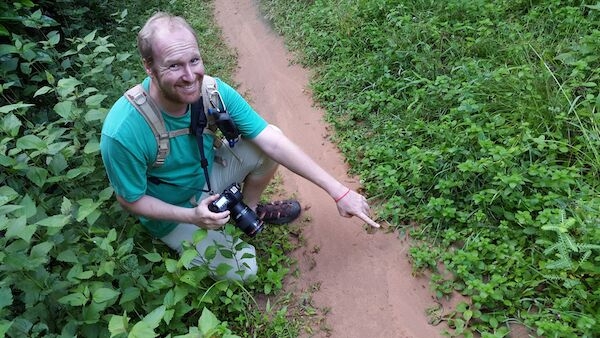
Blue ants of the genus Leptogenys, native to southeast Asia, surround their prey, a massive millipede. It's almost like circling the wagons in a scene from the Wild West. Or "rodeo-style behavior."
The millipede coils into a defensive position. When it lets up its guard, returning to its non-defensive elongated position, the ants attack. One sting, then another, then another. Soon, countless stings. The millipede is doomed.
It's a sight few people ever see. The ants--yes, there is strength in numbers--attack it, kill it, form a living chain, and drag the carcass back to their nest. Their living chain is not unlike what honey bees do in their behavior called "festooning," (which we've seen multiple times at the Harry H. Laidlaw Jr. Honey Bee Research Facility at the University of California, Davis and at other apiaries).
No wonder ants and bees, which belong to the order Hymenoptera, are called "superorganisms."
Belgium-born Stéphane De Greef (and aFacebook friend) captured this amazing video, "Predation on Large Millipedes and Self-Assembling Chains inLeptogenys Ants from Cambodia," which is now an Internet sensation. You can see it here:
Predation on large millipedes and self-assembling chains in Leptogenys ants from Cambodia from Stephane De Greef on Vimeo.
How big is the millipede? It weighs more than 1,000 times that of the tiny ant, De Greef says.
De Greef and evolutionary biologist Christian Peeters, of the Pierre and Marie Curie University in Paris, discovered the previously undocumented behavior back in 2010. Although Peeters specializes in researching the genus, he had never seen the behavior before.
“We were on Phnom Khulen in 2010 looking for some rare ants, and turned around and saw this huge line of ants dragging a millipede,” said De Greef, 36, an environmental engineer, cartographer, nature photographer and nature guide who has lived in Siem Reap, Cambodia since 2002.
Born in 1977 in Wallonia, the French-speaking region of Belgium, De Greef developed and pursued his passion for nature in his early childhood. He spent countless hours "roaming nearby forests, looking for insects, climbing up trees, digging for fossils and exploring caves."
De Greef went on to study environmental sciences in Belgium at at Gembloux's Agro-Bio Tech University (GxABT). There he developed a keen interest in cartography, information management and tropical biodiversity. He received a master's degree in bioengineering (Nature and Forests Management), concentrating his research on the biodiversity of tropical forests in Ecuador and Gabon.
Since then, he's traveled the world, spearheading a wide range of projects and missions.
- Mapping of societies
- Humanitarian Mine Action
- Environment and entomology
- Archaeology and exploration
- Photography
"As an engineer, I have traveled all over the world since 1999, from Latin America to Southeast Asia via Europe and Africa," De Greef says. "I mostly work as an information expert and cartographer in humanitarian and development projects, environment and archaeology."
"As a photographer, my main areas of interest are the natural beauty of people, Nature's amazing diversity and the darkest aspects of human societies, As a video producer, I'm mainly looking into expeditions, news related to explosive devices and human rights violations."
And, all the while, De Greef has been capturing images of widespread interest in Belgium, Burkina Faso, Cambodia, Ecuador, France, Gabon, Haiti, India, Laos, Mali, Nepal, Sudan, the United States and the Western Sahara. (Read more about him in a photography online interview and on his website.)
In reality, de Greef is Ant-Man, Indiana Jones and the insect version of Internet Explorer all rolled into one.
He describes himself: "After playing a key role in 2012 in uncovering the ancient cityscape of Mahendraparvata using LiDAR technology, I now share my time between my nature photography work, most notably for the Meet Your Neighbours project and my Cambodian Bioblitz Initiative, and my nature and countryside discovery tours around Angkor as independent guide."
One thing is for certain: you'll never look at an ant "your" way again after you've seen these blue ants of Cambodia and how they circle, attack, kill, and drag away their prey.
Attached Images:

